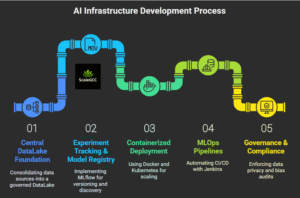Now Reading: How to Build an AI ML Hub in GCC And Beat the Skills Gap
-
01
How to Build an AI ML Hub in GCC And Beat the Skills Gap
- Home
- Technologies
- How to Build an AI ML Hub in GCC And Beat the Skills Gap
How to Build an AI ML Hub in GCC And Beat the Skills Gap
ScaleGCC Editorial TeamTechnologies3 months ago653 Views

How to Build an AI ML Hub in GCC And Beat the Skills Gap
What’s the problem? Building an AI/ML Hub in your GCC isn’t just “nice to have” it’s essential. As businesses race to automate, personalize, and predict, they need robust machine-learning capabilities at scale. Yet talent shortages often stall or fragment these efforts. In India, where 90% of Retail/CPG GCCs are already investing in AI/ML, the competition for skilled data scientists and MLOps engineers is fierce. Without a clear strategy to close these gaps through training, hybrid hiring, and structured processes, your CoE risks missing deadlines, siloed pilots, and stalled innovation. That’s why we tackled this head-on.
Why an AI/ML Hub Matters
You need a centralized AI/ML Hub in our Global Capability Center (GCC) to standardize best practices and accelerate machine-learning projects. India hosts 25% of global Retail/CPG GCCs, and 90% already build digital capabilities so tapping local talent was natural. By creating a dedicated center, you can turn scattered data science efforts into a cohesive team responsible for governance, tooling, and reusable ML assets that serve the entire enterprise.
Overcoming Skills Shortages to Scale GCC
In today’s competitive landscape, talent shortages can derail even the most promising AI/ML initiatives. When most of the GCCs in India are vying for the same data scientists and MLOps engineers, you need a clear strategy to build and retain skilled teams. Bridging this gap not only accelerates project delivery but also ensures your CoE remains a reliable source of innovation rather than a collection of stalled proofs-of-concept.
How to bridge the gap:
Internal Bootcamps: Run focused, hands-on workshops (e.g., Python, TensorFlow) to upskill existing engineers within 6–8 weeks.
Hybrid Hiring: Combine a core in-house team with boutique consultants for niche expertise, mirroring the 91% of GCCs that use third-party partners.
University Partnerships: Collaborate with local institutes to onboard fresh graduates through tailored AI/ML curricula.
Mentorship & Rotation: Rotate team members across pilot projects and production deployments to rapidly build real-world experience.
What may work better in GCC
When you first launch your AI/ML Hub, you will face unclear objectives, scattered data in silos, and pushback from teams unused to agile practices. Here’s how we tackled these real challenges:
Define a Clear Charter: Kick off with leadership workshops to align on goals, reducing inventory waste by 10% and automating invoice reviews.
Appoint CoE Leadership: A director with both technical and business clout unifies stakeholders and drives accountability.
Form Agile Pods: Three cross-functional squads (data engineers, modelers, MLOps) may work in two-week sprints, surfacing issues like missing training data early.
Run Pilot Projects: Demand-forecasting PoC highlighted data-quality gaps, leading us to build a centralized Data Lake before full rollout.
Establish Governance: Introduce reproducibility checks, compliance reviews, and peer code reviews to prevent rogue models and ensure production readiness.
By facing these roadblocks head-on, our AI/ML Hub transformed scattered efforts into a cohesive pipeline that now delivers four model releases per quarter, driving real impact across finance and supply chain.
Engineering a Production-Grade AI Infrastructure
To power repeatable, enterprise-scale ML, we built a standardized stack end-to-end:
Central DataLake Foundation: We consolidated scattered CSVs and APIs into a governed DataLake on S3 ensuring every pod has a single source of truth.
Experiment Tracking & Model Registry: Using MLflow, every experiment, hyperparameter set, and model artifact is versioned and discoverable—so teams never reinvent the wheel.
Containerized Deployment: We packaged models as Docker images orchestrated by Kubernetes, allowing instant scaling during peak loads (we saw 3× faster inference during promotional spikes).
MLOps Pipelines: A Jenkins-driven CI/CD pipeline tests, validates, and deploys models automatically—cutting our manual release time from days to hours.
Governance & Compliance: Automated checks enforce data-privacy rules and bias audits before any model reaches production, giving stakeholders confidence and compliance teams peace of mind.
This infrastructure transformed ad-hoc proofs-of-concept into a reliable, four-model-releases-per-quarter cadence—delivering measurable business impact without firefighting every launch.
Creating Cross-Functional AI Squads
What are AI squads? They’re small, agile teams combining data engineers, ML developers, and MLOps specialists to own specific use cases end-to-end. By breaking down silos, squads ensure faster feedback, clearer accountability, and higher velocity.
How to set them up:
Define Roles: Assign a data engineer for pipelines, an ML developer for model logic, and an MLOps lead for deployments.
Establish Rituals: Run two-week sprints with daily standups, sprint reviews, and retrospectives to keep everyone aligned.
Shared Backlog: Maintain a prioritized list of features, data fixes, and performance improvements so squads always know what matters most.
Why it helps:
Faster Iterations: Issues surface in real time, reducing hand-off delays.
Quality & Ownership: Each squad “owns” its model from data prep through production, boosting code quality and reducing errors.
Scalability: As your AI/ML Hub grows, add more pods without reinventing processes—each squad follows the same workflow, tooling, and governance standards.
It's important to measure your success
You can track key metrics to ensure our AI/ML Hub delivers value:
Deployment Frequency: Increase from 1 to 4 model releases per quarter.
Business Impact: Substitution model can boost customer satisfaction by 10%, mirroring industry leaders.
Cost Savings: Automation of manual reports can cut 40% of data-prep time.
Talent Growth: CoE headcount growth by 25% YoY while maintaining a 90% retention rate through clear career paths and flexible work practices.
Building an AI/ML Hub in your GCC wasn’t easy, but by blending training, hybrid talent, and robust processes, you can conquer the skills shortage. Today, GCC can power multiple high-impact projects across the enterprise, turning data into smarter business decisions. Ready to start your journey? Let our story inspire your next CoE success.
Stay Informed With the Latest & Most Important News
Previous Post
Next Post
Previous Post
Next Post
Interesting Read
Tools3 months ago
GCC Location Feasibility Assessment Tool
Tools1 month ago
Tech Skills Readiness Analyzer
Tools3 months ago
GCC Setup Costs - TCO & ROI Calculator
Tools5 days ago
GCC Vendor Evaluation Framework















